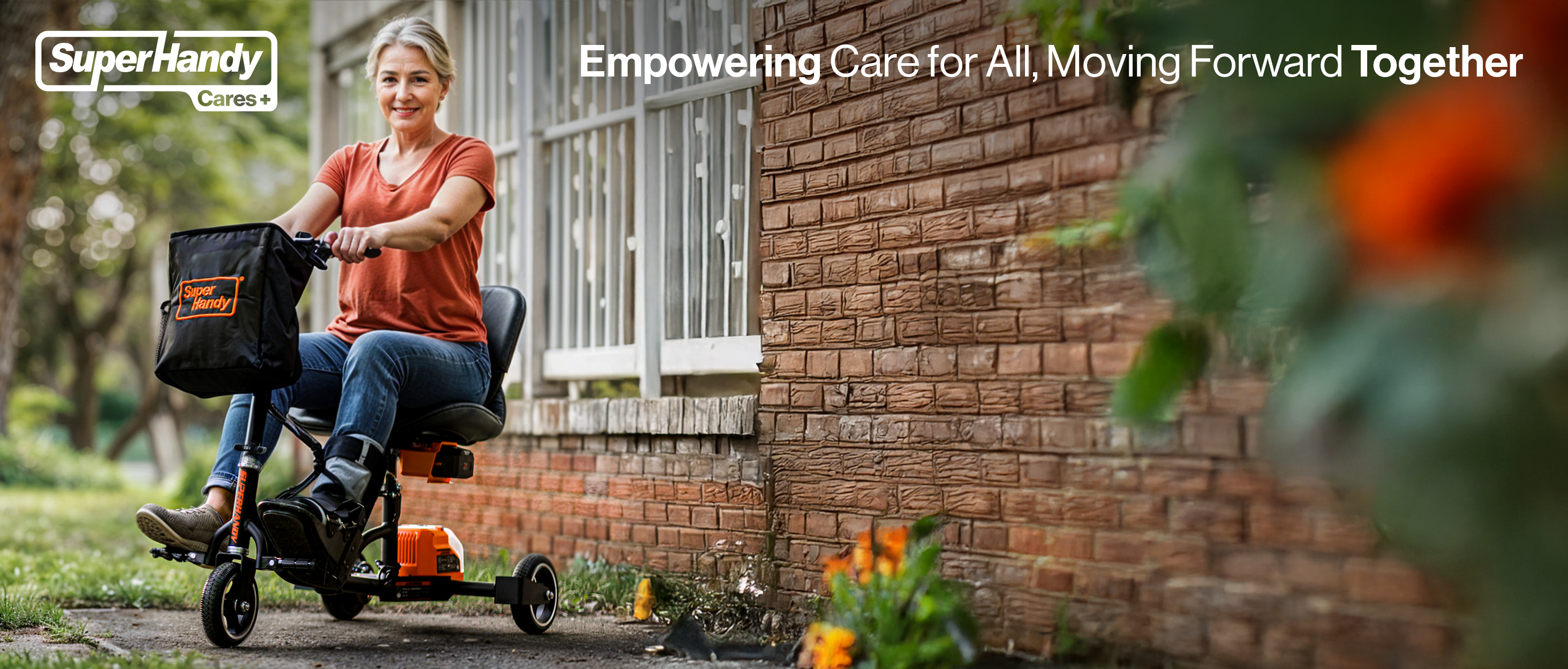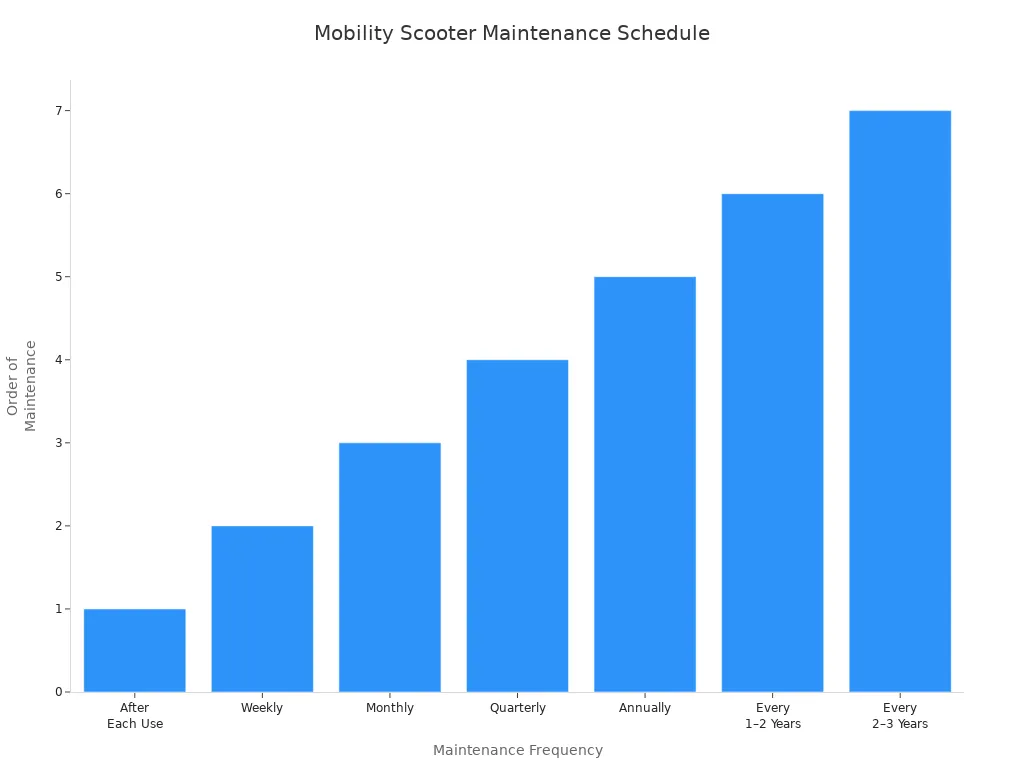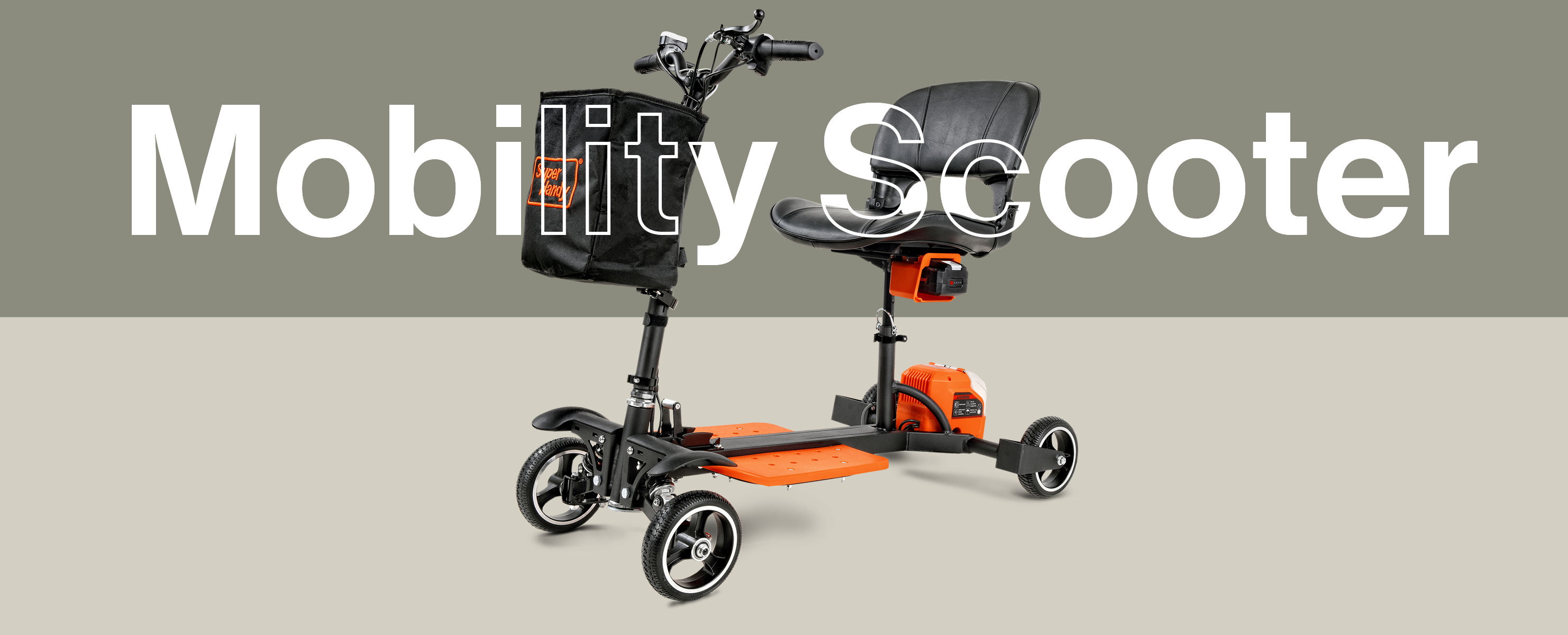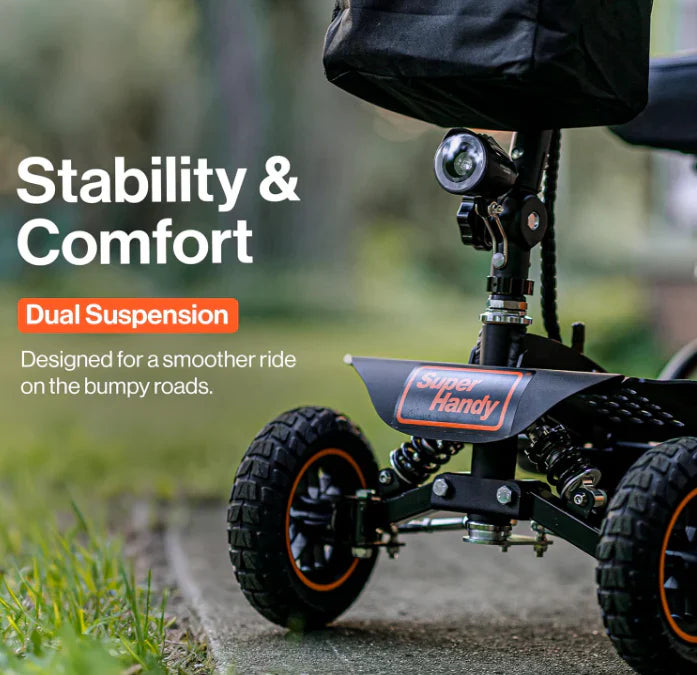You can feel sure when you use a mobility scooter if you know what to do. It is important to stay safe every day. Many people say they feel more free and safe when they use good safety tips.
-
Most injuries happen because of vehicle accidents or falls, so doing things to keep safe can really help.
Key Takeaways
-
Get to know your mobility scooter by reading the manual. Knowing its features makes you feel sure and helps stop accidents.
-
Check your scooter’s tyres, brakes, and battery often to make sure they work well. Regular care stops problems and keeps you safe.
-
Always pay attention and do not get distracted when riding. Watch what is around you to see dangers early and stay safe.
Mobility Scooter Basics
Read the Manual
Before you start using your mobility scooter, take time to familiarise yourself with your scooter. Each model has different features and controls. Reading the manual helps you understand how your scooter works and what to expect. You will find details about the battery, speed settings, and safety features. Knowing these basics gives you more confidence and helps you avoid mistakes.
Tip: Always keep your manual in a safe place. You may need to check it if you have questions later.
Here is a quick guide to the most common types of mobility scooters:
|
Type of Scooter |
Description |
Key Features |
|---|---|---|
|
Compact Scooters |
Lightweight, easy to disassemble, good for short trips. |
Lower weight limit, shorter battery life. |
|
Mid-Sized Scooters |
Good for indoors and outdoors, balanced performance. |
More comfort, longer battery, higher weight limit. |
|
Heavy-Duty Scooters |
Built for rough ground and heavy use. |
Strong frame, big wheels, powerful motor. |
|
Folding Scooters |
Easy to fold and store, great for travel. |
Less comfort, fewer features. |
|
Bariatric Scooters |
Made for higher weight needs, focus on comfort. |
Wide seat, strong frame, higher price. |
Learn Controls
You need to know how to use the controls before you ride. Start by learning these steps:
-
Find the control panel, throttle, and brakes.
-
Practise steering and turning in open spaces.
-
Learn how to get on and off safely.
-
Follow traffic rules and respect others.
Practise Safely
Choose a safe place to practise. Good places include your home, a quiet street, or a flat open area. Try these tips:
-
Start on flat ground.
-
Get used to the controls and how the scooter moves.
-
Practise smooth stops and starts.
-
Make gentle turns and avoid tipping.
Practising in safe areas helps you feel ready for real journeys.
Mobility Scooter Maintenance

Keeping your mobility scooter in top condition helps you stay safe and avoid breakdowns. Routine checks and care make a big difference, especially if you use a battery-powered mobility scooter every day.
Regular Checks
You should inspect your scooter often. Look at the tyres for cuts, cracks, or low tread. Test the brakes before each ride to make sure they stop quickly. Check the throttle and steering for smooth movement. Clean the controls and tyres to keep them working well. Lubricate moving parts if they feel stiff.
Tip: Quick checks each week help you spot problems early and prevent accidents.
Here is a simple guide for how often to do key maintenance tasks:
|
Frequency |
What To Do |
Notes / Replacement Window |
|---|---|---|
|
After Each Use |
Recharge batteries fully; wipe down controls as needed. |
Avoid deep discharges. |
|
Weekly |
Visual tyre check; quick brake test. |
Look for cuts, low tread, or slow stopping. |
|
Monthly |
Check tyre pressure; tighten hardware; test lights. |
Most scooters: ~30–40 PSI. |
|
Quarterly |
Inspect wiring; listen for odd noises; clean axles. |
Fix humming or grinding early. |
|
Annually |
Check alignment, suspension, brakes, and electrics. |
Do sooner if ride feels rough. |

Battery Care
Your scooter’s battery needs special attention. Always recharge after each use and avoid letting the battery drop below 30%. Store your scooter in a cool, dry place. Use the charger that came with your scooter. Do not overcharge or let the battery run flat. If you plan to store your scooter for a long time, keep the battery at about 50% charge and top it up every two weeks.
-
Charge after every use.
-
Avoid deep discharges.
-
Store in a cool, dry place.
-
Top up every two weeks if not in use.
Tyres and Brakes
Tyres and brakes keep you safe on the move. Inflate tyres to the recommended pressure, usually 30–40 PSI. Look for signs of wear or damage. Replace tyres if you see cracks or low tread. Test the brakes before each journey. If you notice slow stopping or strange noises, get them checked right away.
Note: Well-maintained tyres and brakes help you avoid slips and accidents.
Essential Safety Tips
Speed Limits
You must know the legal speed limits for your mobility scooter. Following these limits helps you avoid accidents and keeps you safe. Different regions set their own rules.
You should always check local laws before you ride. If you go faster than the limit, you increase your risk of a crash by more than ten times. Crashes become much more severe when you ignore speed rules. Take it slow, especially in busy areas or near pedestrians. You protect yourself and others when you follow these scooter safety tips.
Tip: Take it slow on pavements and crowded places. You stay safer and avoid risky manoeuvres.
Balance and Awareness
Balance and awareness play a big part in mobility scooter safety. You need to stay alert and keep your body steady, especially in tight spaces. Compact scooters help you move easily indoors and around corners. You should practise steering and stopping in small areas. Look ahead and plan your moves. Watch for obstacles like bins, pets, or uneven ground.
-
Keep both hands on the controls.
-
Sit upright and avoid leaning too far.
-
Slow down before you turn.
-
Scan your surroundings for hazards.
If you take it slow and stay aware, you lower your chance of tipping or falling. These safety tips help you feel more confident and support safe use every day.
Avoid Curbs and Stairs
Never try to drive your mobility scooter up or down curbs or stairs. Falls on stairs cause many injuries, such as fractures, cuts, and bruises. Older adults face higher risks of head and torso injuries from these accidents. You should look for ramps, lifts, or elevators instead. Accessible paths keep you safe and prevent serious harm.
-
Avoid curbs and stairs at all times.
-
Use marked crossings and ramps.
-
Ask for help if you cannot find a safe route.
Note: Most falls happen on stairs. You protect yourself by choosing safe paths and following these safety tips.
Mobility scooter safety means you must plan your route and avoid risky areas. You stay independent and safe when you follow these scooter safety tips.
Safe Riding Habits

Stay Alert and Avoid Distractions
You need to stay alert and avoid distractions every time you use your mobility scooter. Many accidents happen when riders or drivers do not pay full attention. Distractions can come from mobile phones, navigation screens, or even looking away from the path. If you lose focus, you risk making poor decisions or missing hazards. Always monitor surroundings and keep your eyes on where you are going. This habit helps you spot dangers early and react quickly.
Tip: Take a moment before each journey to clear your mind and focus on the road ahead.
No Mobile Use
You should avoid phone use while riding. Using a mobile phone, even for a quick message, takes your attention away from the path. This can lead to accidents or near misses. If you need to make a call or check your phone, stop your scooter in a safe place first. Remember, safety comes first. Many distraction-related accidents happen because riders try to multitask. Keep both hands on the controls and your mind on the journey.
Control Speed
Controlling your speed is a key part of safe riding. You must adjust your speed for different places and situations. Here are some effective ways to manage your speed:
-
Use variable speed control to match your comfort and the environment.
-
Set the max speed limit to prevent going too fast.
-
Use reverse speed control for safe backing up.
-
Rely on speed inhibitors to slow down on hills or sharp turns.
You protect yourself and others when you ride at a safe pace. Always slow down in busy areas or when you see obstacles. Good speed control helps you avoid sudden stops and keeps your journey smooth.
Navigating Outdoors
Terrain and Hills
Riding your mobility scooter outside can be tough. Some surfaces make it hard to stay in control. The table below lists common terrain and their problems:
| Terrain Type --- Challenges | | Grass --- Hard to balance because the front wheel is small. | | Gravel --- Needs more effort and care than flat ground. | | Inclines --- Scooters may slow down or stop on hills. | | Declines --- Scooters can speed up quickly, so be careful. |
Most scooters have small wheels and simple suspension. This makes rough ground harder to cross. Weak motors find gravel, grass, or dirt paths difficult. Try to use smooth pavements and avoid steep hills if you can.
Weather Conditions
Weather affects how your scooter works. Rain and snow make the ground slippery and hide dangers. Go slower and brake sooner because wet ground means longer stopping. Wear bright or reflective clothes so people see you. Stay away from puddles as they might hide holes or rubbish. If you ride in snow, use winter tyres and add bright panels or lights. A waterproof cover keeps your scooter dry and stops damage.
Tip: Check your scooter often after rain or snow to keep it working well.
Crowded Areas
Crowded places need you to be extra careful. Go slower so you can control your scooter better. Look at people around you so they know you are there. If you reach a tight space, ask nicely to pass or wait for the crowd to move. Use a bell or horn to let people know you are coming but do not scare them. These habits help you stay safe and make public places nicer for everyone.
Visibility and Communication
Lights and Reflectors
You need to make sure your mobility scooter stands out, especially when light is low. Proper lighting helps you see obstacles and lets others spot you from a distance. Bright LED headlights, rear lights, and brake lights all play a part in keeping you safe. If your scooter has poor lighting, you risk dangerous situations. Reflectors add extra safety by catching car headlights and street lamps. You lower accident risks when you use a complete lighting system.
Tip: Check your lights and reflectors before every journey. Replace broken bulbs or faded reflectors right away.
Bright Clothing
You should always dress for visibility. Bright colours and reflective strips on your clothing help drivers and pedestrians notice you. A high-visibility vest or jacket works well in fog, rain, or at night. You can also add reflective bands to your arms or legs. These simple steps make you stand out and reduce the chance of accidents.
| Clothing Type --- Visibility Level | | Yellow Vest --- Very High | | Orange Jacket --- High | | Reflective Bands --- Medium | | Dark Coat --- Low |
Signalling
You must let others know what you plan to do. Use clear hand signals to show when you want to turn or stop. Cyclists use these signals, and you can use them too. Good communication prevents confusion and keeps everyone safe.
-
Extend your arm left or right to show a turn.
-
Raise your hand to signal a stop.
-
Make eye contact with others when possible.
Note: Always check your surroundings before you signal. Practice signals at home until you feel confident.
Rules and Planning
Pedestrian Laws
You need to know the rules for using mobility scooters in public. Most countries treat mobility scooters like pedestrians. You can ride on pavements and pedestrian paths. Do not use roads unless your local area says it is allowed. Always use the right paths to keep everyone safe. Many places want you to cross at marked crossings only. Some cities have extra rules, so check what your area says. If you break traffic laws, you might get a fine or other trouble. Pavements must be safe for all, especially older people and children.
-
Mobility scooters can go on pavements and pedestrian paths.
-
You must cross roads at marked crossings.
-
Local rules may change for scooter size or speed.
-
Always watch out for others to avoid problems.
Route Planning
Planning your route helps you stay safe and avoid danger. Look for pavements that are smooth and well lit. Try to find easy crossings and avoid steep hills or rough ground. If you use public transport, check if buses or trains have ramps or space for scooters. You can ask your local council about safe routes for mobility scooters. Good planning lowers your risk and keeps you safer.
Accessibility
Check if your route is easy to use before you travel. Some places have ramps, lifts, or special crossings for mobility scooters. Newer buses often have automatic ramps, but old ones may have manual ramps. Look for wide pavements, dropped kerbs, and clear signs. If you use public transport a lot, a compact or foldable scooter is helpful. Many buses have spaces for scooters, but make sure your scooter fits and does not block the way.
-
Automatic or manual ramps help you get on buses and trains.
-
Special seating areas keep your scooter safe.
-
Accessibility can change in different cities, so plan ahead.
Tip: Always check your route and transport before you leave home. This helps you avoid problems and keeps your journey safe.
You can make using your mobility scooter better by using these safety tips:
-
Practise a lot so you do not crash or get hurt.
-
Look after your scooter so it works well every time.
-
Learn new things from training and guides you can read.
-
Pick safe paths and follow the rules in your area.
Always pay attention, keep learning, and feel sure when you ride each day.
FAQ
Can you ride a mobility scooter in the rain?
You can ride in light rain, but avoid heavy rain or deep puddles. Water can damage your scooter’s electronics. Use a waterproof cover for extra protection.
How often should you check your scooter’s tyres?
Check your tyres every week. Look for cracks, low tread, or low pressure. Replace tyres if you see damage. Good tyres help you stay safe.
What should you do if your battery runs out while outside?
-
Move your scooter to a safe place.
-
Call a friend or family member for help.
-
Use your mobile to contact a taxi or recovery service.

